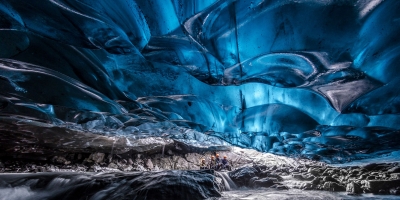
Iceland is home to the largest glacier in Europe – Vatnajokull. Consider its immense dimensions – it covers an area of 8100-8300 sq. km and is about 400 m thick on an average, with a maximum thickness of 1000 m at one point.
Beneath the surface of the vast icy landscape, lie seething volcanoes which give rise to hot springs and geysers. This magical blend of fire and ice plays out to spectacular effect in Kverkfjöll, a 2.8km-long icy cavern system caused by the geothermal activity of the region.
The mountain range of Kverkfjöll is located in the north of the glacier. Its glacier cave was first explored in the 1980s by a French expedition. However, glacial caves keep changing in form as the geothermal heat melts the ice; so the cave you see today is different from what the first explorers had seen.
There are two sets of caves – the Lower and Upper Kverkfjöll Ice Caves. As one enters the extraordinary world of icy splendour, the centuries-old ice shimmers in stunning shades of blue. However, the caves are unstable and dangerous especially in summers when blocks of ice collapse near the entrance. Hence the caves are normally visited in winter.
Picture Credit : Google

